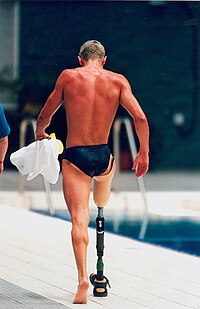
Photo from wikipedia
Musculoskeletal modeling and marker-based motion capture techniques are commonly used to quantify the motions of body segments, and the forces acting on them during human gait. However, when these techniques… Click to show full abstract
Musculoskeletal modeling and marker-based motion capture techniques are commonly used to quantify the motions of body segments, and the forces acting on them during human gait. However, when these techniques are applied to analyze the gait of people with lower limb loss, the clinically relevant interaction between the residual limb and prosthesis socket is typically overlooked. It is known that there is considerable motion and loading at the residuum-socket interface, yet traditional gait analysis techniques do not account for these factors due to the inability to place tracking markers on the residual limb inside of the socket. In the present work, we used a global optimization technique and anatomical constraints to estimate the motion and loading at the residuum-socket interface as part of standard gait analysis procedures. We systematically evaluated a range of parameters related to the residuum-socket interface, such as the number of degrees of freedom, and determined the configuration that yields the best compromise between faithfully tracking experimental marker positions while yielding anatomically realistic residuum-socket kinematics and loads that agree with data from the literature. Application of the present model to gait analysis for people with lower limb loss will deepen our understanding of the biomechanics of walking with a prosthesis, which should facilitate the development of enhanced rehabilitation protocols and improved assistive devices.
Journal Title: International journal for numerical methods in biomedical engineering
Year Published: 2018
Link to full text (if available)
Share on Social Media: Sign Up to like & get
recommendations!